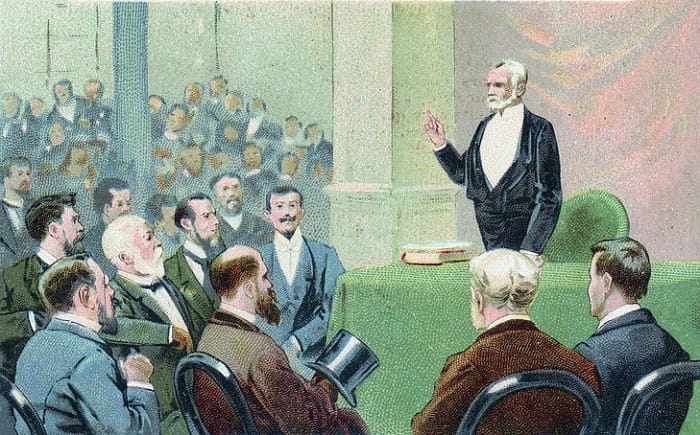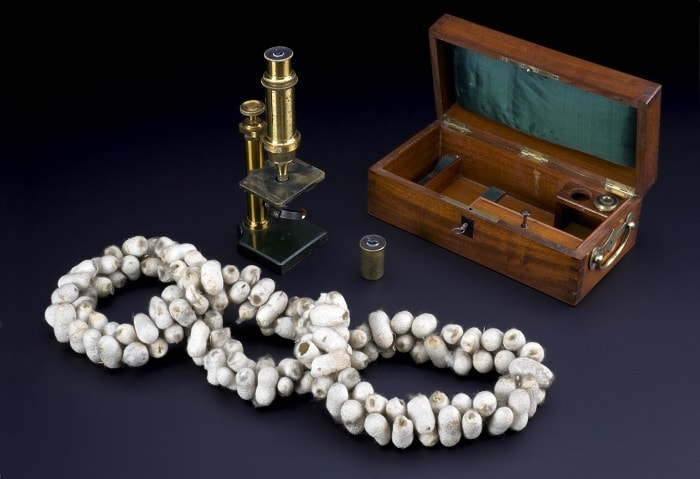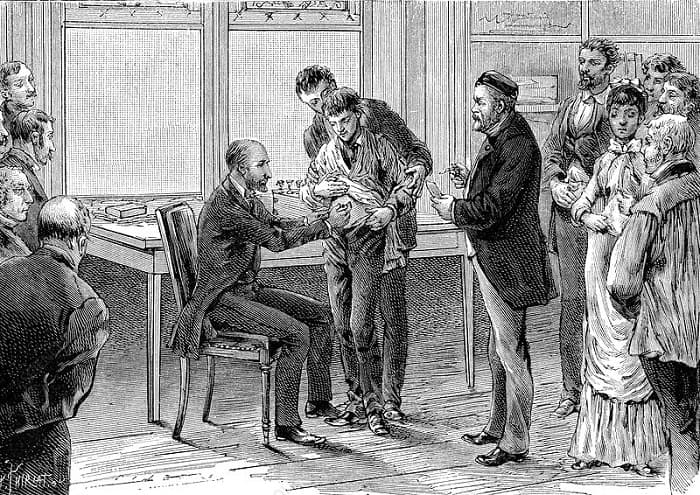When Louis Pasteur died in 1895, he was a national hero in France and became internationally famous as well. The public got to know him most with his work on the prevention and treatment of infectious diseases in the last years of his life. But for the scientific community, he was the person who started the field of stereochemistry, showed that fermentation is a biological process, disproved the theory of spontaneous generation, explained how diseases work on a biological level, helped establish the microbe theory, and showed the economic and social benefits of experimental laboratory research in many fields.
Although Pasteur’s position was partly based on his own advertising, it was actually due to the wide-ranging achievements of microbiology in its theory and practice. Gerald Geison wrote for him: “While he often exhibits great courage and a powerful imagination, the characteristic features of his work, in general, are clear mindset, extraordinary experimental skills, perseverance, and even stubbornness.“
Who was Louis Pasteur?

Pasteur was born in Dole, in the east of France, and his father was a tanner. He went to school in Arbois and Besançon, and his grades were good enough to be recommended for the entrance exams of the respected Ecole Normale Supérieure in Paris. He failed the exam in 1842 but succeeded the next year. He chose physical sciences, and after he finished his undergraduate degree, he focused on crystallography, a new field in physics and chemistry, and got a double doctorate in it.
He studied the chemical formula and the relationship between the crystalline forms of sodium tartrate. Scientists were interested in different, that is, isomorphic, chemicals with very similar chemical structures. Salts of tartaric acid were of particular interest. Because of dimorphism, the microscope revealed that the two forms are mirror images of each other. Of course, luck played a role: crystallization is extremely heat-sensitive, and Pasteur was working at the most appropriate time of the year. Sodium tartrate shows this asymmetry more clearly than almost any other salt. He found that crystals that come from nature have the same polarization properties as those that are made in a lab.
Through long and difficult observations, he revealed that natural crystals always have right-handed material, while synthetic crystals have equal amounts of right and left material. This meant that the polarization properties neutralized each other. In this study, Pasteur’s scientific style is defined by five things: his ability and willingness to experiment, his use of the microscope, his interest in how life works chemically, how he made the most of luck, and how important his results were.
In 1849, Louis Pasteur transferred to Strasbourg University as a professor of chemistry, continuing to work on asymmetry and enjoying his growing reputation. His private life changed when he married Maria Laurent, the daughter of the university president. Marie provided both financial and moral support for his career. Six years later, he was appointed dean of the newly established Science Faculty at Lille University and moved there. He welcomed the university’s mission to combine research with teaching and science practice to support the local industry. He taught lectures on bleaching, refining, and brewing but continued his research in the field of asymmetric compounds and optical activities.
The great fermentation controversy

Pasteur’s great interest in the chemistry of living organisms led him to investigate fermentation and especially the role of yeast in alcohol production. In 1857, he gave a speech on lactic acid and amyl alcohol, the common by-products of bad fermentation. He argued that the asymmetric optical properties of amyl alcohol came from the fermentation process, which was related to living organisms. This was against the common idea that fermentation is a chemical process.
Returning to the Ecole Normale as director of scientific research in 1860, Pasteur published his main work, which finalized the biological explanation of fermentation. It was interesting that a person trained in chemistry and physics advocated vitalism, emphasizing the uniqueness of life and the fact that life cannot be reduced to material forces. Pasteur turned his microscope from crystal structures to fermented grapes and sour milk, observing large molecules such as yeast and other ferments that were previously supposed to change shape in the process. It once again affirmed that yeast consists of living cells or microorganisms.
During the fermentation studies, there was a very famous contrast between Pasteur and Félix Archimède Pouchet on the spontaneous generation of life. Pasteur first made a speech against spontaneous generation in February 1860, publishing an article the following year dealing with the fact that life always derives from an earlier life. He received an award for this article. The subject of his work was leavening in liquid mixtures and the deterioration of natural products. He argued that these could always generate spontaneously without contamination from live organisms.
Two scientists embarked on a scientific duel, with mutual scientific results and polemics being presented and sophisticated sterilization techniques mixed with religious inferences over whether life was constantly created. Louis Pasteur defended the general view that life was created by God in the distant past and could not be created by simple physical force. This strife not only resulted in the consensus of the scientific community but, unusually, in the judgment of the committees of the French Academy of Sciences in favor of Pasteur and against spontaneous generation.

This contrast led Pasteur to a new field: the research of disease in animals and humans. Doctors had long thought that the development of fever and septic infections was similar to fermentation and spoilage. Thinking that these processes involve living organisms or microbes raised new questions. Of course, the link was speculative, and this was well reflected in the phrase “germ theory of diseases.” The term “microbe” explained that these organisms were very diverse, very common in the environment, especially in the air, and were potentially powered by fission; the fact that it was a “theory” meant that the link that is needed to show they caused the disease still had to be proven.
Following the practical applications of the microorganism theory to fermentation and spoilage, Pasteur found that heating the wine to 50 degrees killed yeast cells and prevented spoilage. The same method is still used to prevent milk from spoiling and is called pasteurization. The most famous application of Pasteur’s germ theory was the development of antiseptic methods by British surgeon Joseph Lister, who assumed that the septic infection of wounds was related to microorganism contamination, leading to rotting. Lister had always given Pasteur credit for his work, and he became Pasteur’s most well-known supporter by extending Pasteur’s germ theory to all infections and diseases that spread from person to person.
Pasteur’s application of science to practical problems prompted the French government to demand that he lead a team to study the disease that had arisen in the silk industry in 1865. After three years of investigation, the disease was attributed to a parasite, and they recommended ways to keep silkworms healthy and free from germs. Pasteur’s success provided a more distinguished view of the theory that diseases are germ-borne. Tests have begun in medical research around the world. But during one of his projects, Pasteur had a stroke. This didn’t slow him down or change how hard he worked in school, but his left side was partially paralyzed for the rest of his life.
Pasteur’s first study of microbial diseases was on anthrax, which was not only one of the main problems of the French livestock industry but also affected humans. The bacterial cause was identified in 1876 by Robert Koch. Although Pasteur is best known for the vaccine he produced for this disease, he opposed some aspects of Koch’s work. He predicted that a mild disease could revert to a virulent strain based on the principle of smallpox vaccination. He exposed the anthrax bacteria to the air, and its virulence decreased. The laboratory results were successful. So he undertook a field trial at Pouilly-le-Fort, near Paris, in 1881.
Twenty-five sheep were vaccinated, and an equal number of sheep were in the control group. Two weeks later, all of them were infected with anthrax. Nearly all of the vaccinated sheep survived, while almost all of those who were not vaccinated died. Pasteur’s work had shown that in addition to directly benefiting French farmers, vaccination could be applied to many, if not all, infectious diseases. At the International Medical Congress in 1881, he was treated like a star, and the French government gave him a lot of help.
Louis Pasteur and the rabies vaccine

But even bigger improvements were imminent. His next project was a protective vaccine against rabies. Its unpredictability and the fact that the symptoms, once they appeared, brought about a terrible death that could not be prevented were causing great concern in the public. Pasteur and his increasing number of assistants first reproduced the disease in laboratory dogs and rabbits under controlled conditions. The first trials with dogs were successful. Then, because of public pressure and more trust in the new vaccine, they switched to testing on people.
However, the rabies vaccine was not used for protection but to treat people who were already infected. The aim was to strengthen immunity by taking advantage of the long incubation period. The first human subject was a boy named Joseph Meister, who was bitten by a rabid dog in eastern France. It was brought by her parents, who knew of Pasteur’s possible life-saving treatment. The boy survived with treatment. After this case, the vaccine was tried on another child, and the result was again positive. Once it was made public in October 1885, rabid dog-bitten victims from France and Europe, and soon all over the world, flocked to Paris to receive this free treatment.
The press published Pasteur’s newly popular rabies treatment on their front pages. They celebrated Pasteur as the great scientist and humanist who promised to rid humanity of infectious diseases. He received many new awards, but most importantly, there were donations from the public that allowed him to set up an institute to develop further vaccines and other life-saving innovations. With donations from around the world, the Pasteur Institute officially opened in November 1888.
This great man’s health had deteriorated. Although he was still in the laboratory and the clinic, he could not take an active role in any research. When he died in 1895, it was proposed that he be buried in the Pantheon alongside other French heroes with a large public funeral. But Pasteur and his family had already made their plans. The best place to bury a scientist who changed the role of laboratory research in science and public relations was in the crypt at his institute.
Bibliography:
- Gradmann, Christoph (2006). “Robert Koch and the white death: from tuberculosis to tuberculin”. Microbes and Infection. 8 (1): 294-301. doi:10.1016/j.micinf.2005.06.004. PMID 16126424.
- Lane, Nick (2015). “The unseen world: reflections on Leeuwenhoek (1677) ‘Concerning little animals'”. Philosophical Transactions of the Royal Society of London. Series B, Biological Sciences. 370 (1666): 20140344. doi:10.1098/rstb.2014.0344. PMC 4360124. PMID 25750239.
- Seckbach, Joseph, ed. (2004). Origins: Genesis, Evolution and Diversity of Life. Dordrecht, The Netherlands: Kluwer Academic Publishers. p. 20. ISBN 978-1-4020-1813-8.
- Ullmann, Agnes (August 2007). “Pasteur-Koch: Distinctive Ways of Thinking about Infectious Diseases”. Microbe. 2 (8): 383–387.
- Geison, Gerald L (1995). The Private Science of Louis Pasteur. Princeton, NJ: Princeton university press. ISBN 978-0-691-01552-1.
- Anderson, C. (1993). “Pasteur Notebooks Reveal Deception”. Science. 259 (5098): 1117. Bibcode:1993Sci…259.1117A.
- Louis Pasteur (1822–1895) | ENS”. www.ens.psl.eu.
- Louis Pasteur, Thèse de Chimie, Thèse de Physique. 1847.
- “History of the Cholera Vaccine | Passport Health”. www.passporthealthusa.com.

